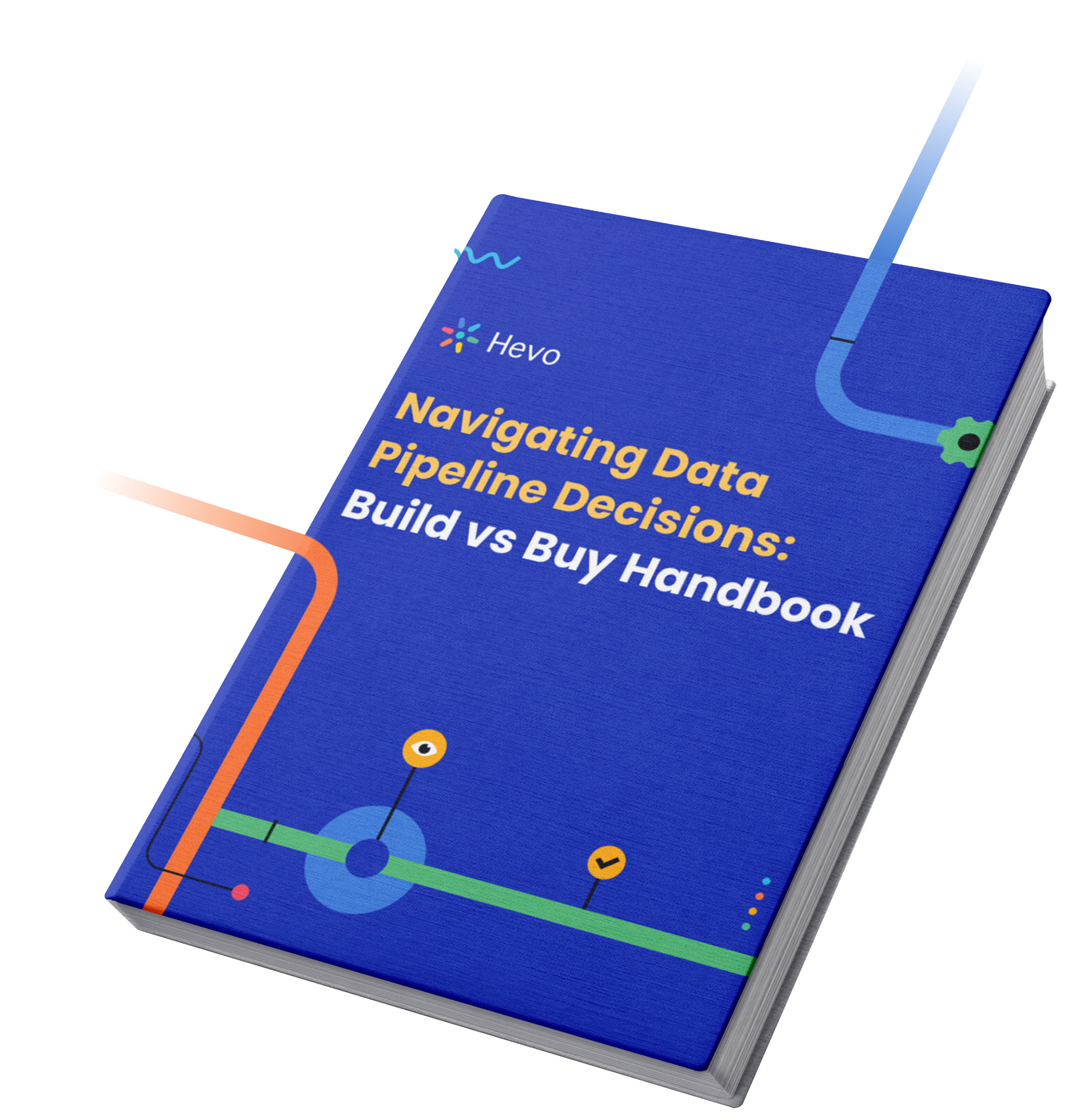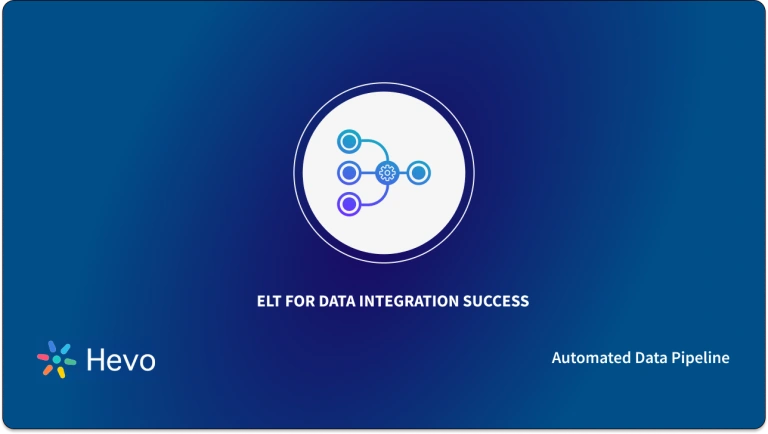 Key Takeaways
Key TakeawaysHere are the 8 best open-source ETL tools:
1. Hevo Data: Best for no-code ETL with zero maintenance and real-time data pipelines
2. dbt (Data Build Tool): Best for SQL-based data transformation and analytics engineering workflows
3. Airbyte: Best for open-source data integration with extensive connector library
4. Apache Kafka: Best for real-time streaming data processing and event-driven architectures
5. Pentaho Data Integration: Best for comprehensive ETL with visual workflow design
6. Singer: Best for lightweight, modular data extraction and loading
7. PipelineWise: Best for replicating data from multiple sources to data warehouses
8. Apache NiFi: Best for automated data flow management and real-time data routing
As data continues to grow at an unprecedented rate, the need for an efficient and scalable open-source ETL solution becomes increasingly pressing. However, with every organization’s varying needs and the cluttered market for automated tools, finding and choosing the right tool can be strenuous.
I reviewed over 10 tools and have curated an open-source ETL tools list, ranked by popularity with their features, pros and cons, and customer reviews to help you choose a tool that aligns with your data requirements and supports hassle-free data integration capabilities.
If you don’t have the time to read through our research, here is our quick comparison table of the best open-source ETL tools that you should consider.
- 1No-code platform to load, transform, and sync data from 150+ sources.Try Hevo for Free
- 2Open-source tool to sync data from 550+ sources into any destination.
- 3Distributed platform for building real-time, high-throughput data pipelines.
- 17Tools considered
- 12Tools reviewed
- 8Best tools chosen
For some of you who are ever curious, our team also compiled a list of other data integration tools that you could leverage.
Table of Contents
What is ETL?
ETL is a method of Extract, Transform, and Load. It refers to the process of taking the data from multiple sources to a centralized system for easy and reliable access, such as a warehouse. ETL makes the data consistent and correct for decision-making with proper insights as it is critically responsible in data-driven decisions.
- Extract: Extract gathers raw data from any variety of sources, for instance, databases, APIs, or flat files.
- Transform: The extracted data is cleansed, formatted, and transformed in a form to make use of it. This might even include filtering, aggregation, or de-duplication.
- Load: Transformed data is loaded in the target system for analysis, reporting, or any other business purpose.
Check out our latest blog on ETL vs. iPaaS to explore the key differences.
| Reviews |  4.5 (250+ reviews) |  4.8 (150+ reviews) |  4.5 (50+ reviews) |  4.5 (100+ reviews) |  4.3 (10+ reviews) |
| Pricing | Usage-based pricing | Open-source + Pay as you go pricing | Volume/capacity-based pricing | Open-source | Open-source + Usage-based pricing |
| No-code UI |  |  |  | ||
| Real-time Sync |  |  |  | ||
| Open-source |  |  |  |  | |
| Cloud-native |  |  |  |  | |
| Self-hosting |  |  |  |  | |
| Pre-built Connectors | 150+ built-in | Not available | 300+ sources | Not available | 50+ sources |
| Custom Connectors | Webhooks only | Not supported | Python SDK | APIs available | Java extensions |
| Transformation | SQL + visual | SQL only | dbt-based | Custom apps | SQL + UI |
| CDC Support |  |  | |||
| Data Quality Checks | Basic profiling | Tests + contracts | Limited rules | Not available | Manual setup |
| Streaming Data |  |  | |||
| Orchestration | Built-in | Via Airflow | Airflow optional | External only | Job designer |
| Ease of Use | Very easy | Moderate CLI | Easy UI | Complex setup | Moderate |
Comparing the Best Free Open-source Tools For ETL
1. Hevo Data
G2 Rating: 4.4
Founded in: 2017
Hevo is the only real-time ELT No-code Data Pipeline platform that cost-effectively automates flexible data pipelines to your needs. You can replicate data in near real-time from 150+ data sources to the destination of your choice, including Snowflake, BigQuery, Redshift, Databricks, and PostgreSQL.
For the rare times things do go wrong, Hevo ensures zero data loss. To find the root cause of an issue, Hevo also lets you monitor your workflow so that you can address the issue before it derails the entire workflow. Add 24*7 customer support to the list, and you get a reliable tool that puts you at the wheel with greater visibility.
Hevo is not an open-source tool, but it’s a go-to solution for fast-growing companies and trusted by customers across industries.
Hevo Data ETL Features
- Data Deduplication: Hevo deduplicates the data you load to a database Destination based on the primary keys defined in the Destination tables.
- Schema Management: Hevo eliminates the tedious task of schema management. It automatically detects the schema of incoming data and maps it to the destination schema.
- Data Transformation: Hevo supports Python-based and drag-and-drop transformations to cleanse and prepare the data for loading to your destination.
- Incremental Data Load: Hevo allows the transfer of data that has been modified in real time. This ensures efficient utilization of bandwidth on both ends.
Pricing
Hevo has a simple and transparent pricing model with 3 usage-based plans, starting with a free tier that allows you to ingest up to 1 million records.
Hevo Resources
Looking for the best tool to connect your data sources for ETL process? Rest assured, Hevo’s no-code platform helps streamline your ETL process. Try Hevo and equip your team to:
- Integrate data from 150+ sources(60+ free sources).
- Simplify data mapping with an intuitive, user-friendly interface.
- Instantly load and sync your transformed data into your desired destination.
You can see it for yourselves by looking at our 2000+ happy customers, such as Airmeet, Cure.Fit, and Pelago.
Get Started with Hevo for Free2. dbt (Data Build Tool)
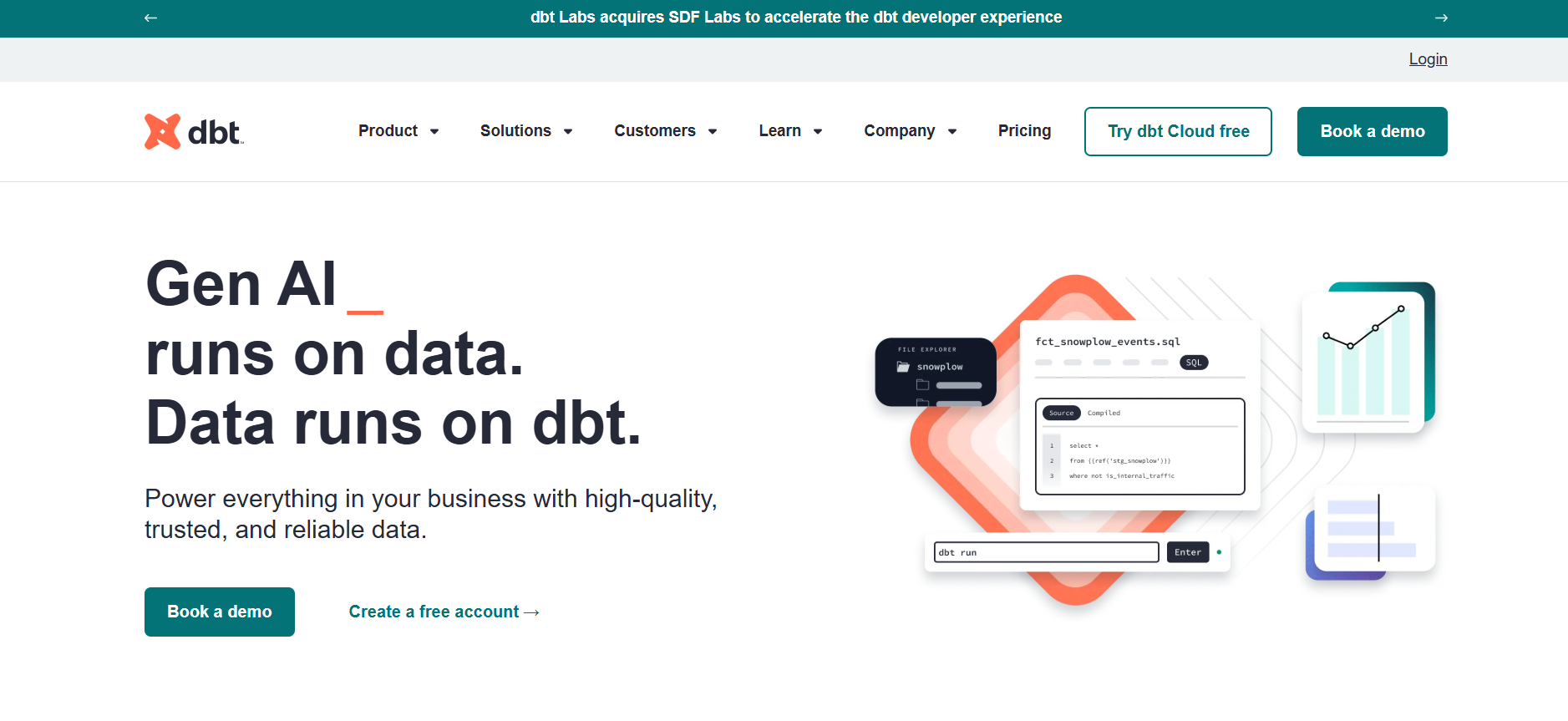
G2 Rating: 4.8
Founded in: 2021
dbt is an open-source software tool designed for data professionals working with massive data sets in data warehouses and other storage systems. It enables data analysts to work on data models and deploy analytics code together using top software engineering practices, such as modular design, portability, continuous integration/continuous deployment (CI/CD), and automated documentation.
dbt ETL Features
- SQL-based Transformations: I used SQL to make direct transformations to data, without relying on external transformation languages or ELT tools that use graphical interfaces.
- Data Warehouse-Oriented: I transformed and modeled data within the data warehouse, such as Snowflake, BigQuery, or Redshift, instead of extracting, transforming, and loading (ETL) data into a separate data space.
- Built-in Testing: dbt’s built-in testing feature checks for data integrity and accuracy during transformations, helping to catch and correct errors easily and efficiently.
Pros
- Open-source: dbt, being open-source, offers an extensive library of installation guides, reference documents and FAQs. It also offers access to dbt packages, including model libraries and macros designed to solve specific problems, providing valuable resources.
- Auto-generated documentation: Maintaining data pipelines becomes easy for users like you as the documentation for data models and transformations is automatically generated and updated.
Cons
- dbt can only perform transformations in an ETL process. Therefore, you’ll need other data integration tools to extract and load data into your data warehouse from various data sources.
- If you’re not well-versed in SQL, it won’t be easy for you to utilize dbt as it is SQL-based. Instead, you could find another tool that provides a better GUI.
dbt Resources
Documentation | Developer Blog | Community
3. Airbyte
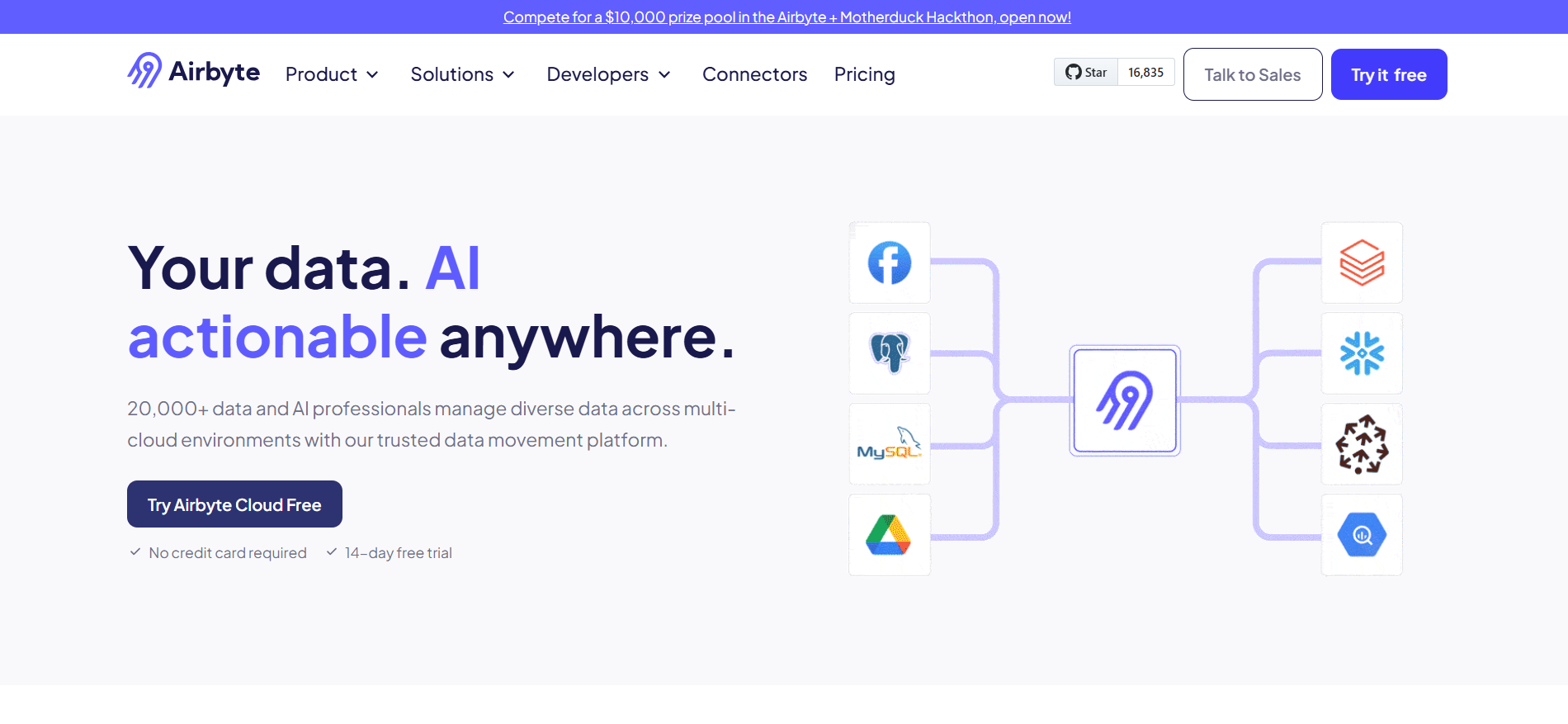
G2 Rating: 4.5
Founded in: 2020
Airbyte is one of the top open-source ELT tools with 300+ pre-built connectors that seamlessly sync both structured and unstructured data sources to data warehouses and databases.
Airbyte ETL Features
- Build your own Custom Connector: Airbyte’s no-code connector builder allowed me to create custom connectors for my specific data sources in just 10 minutes. The entire team can also tap into these connectors, enhancing collaboration and efficiency.
- Open-source Python libraries: Airbyte’s PyAirbyte library packages Airbyte connectors as Python code, eliminating the need for hosted dependencies. This feature leverages Python’s ubiquity, enabling easy integration and fast prototyping.
- Use Airbyte as per your Use case: Airbyte offers two deployment options that can fit your needs perfectly. For simpler use cases, you can leverage their cloud service. But you can self-host
Pros
- Multiple connectors: Airbyte simplifies and facilitates data integration through its wide availability of connectors. Users on G2 acclaim it as ” a simple no-code solution to move data from A to B”, ” a tool to make data integration easy and quick,” and “The Ultimate Tool for Data Movement: Airbyte.”
- No-cost: As an open-source tool, Airbyte eliminated the licensing costs associated with proprietary tools for me. A user on G2 claims Airbyte to be “cheaper than Fivetran, easier than Debezium”
- Handles large volumes of Data: It efficiently supports bulk transfers. A user finds this feature the best about Airbyte: “Airbyte allowed us to copy millions of rows from a SQL Server to Snowflake with no cost and very little overhead”.
Cons
- As a newer player in the ETL landscape, Airbyte does not have the same level of maturity or extensive documentation compared to more established tools.
- The self-hosted version of Airbyte lacks certain features, such as user management, that makes it less streamlined for larger teams.
Airbyte Resources
Documentation | Roadmap | Slack
4. Apache Kafka
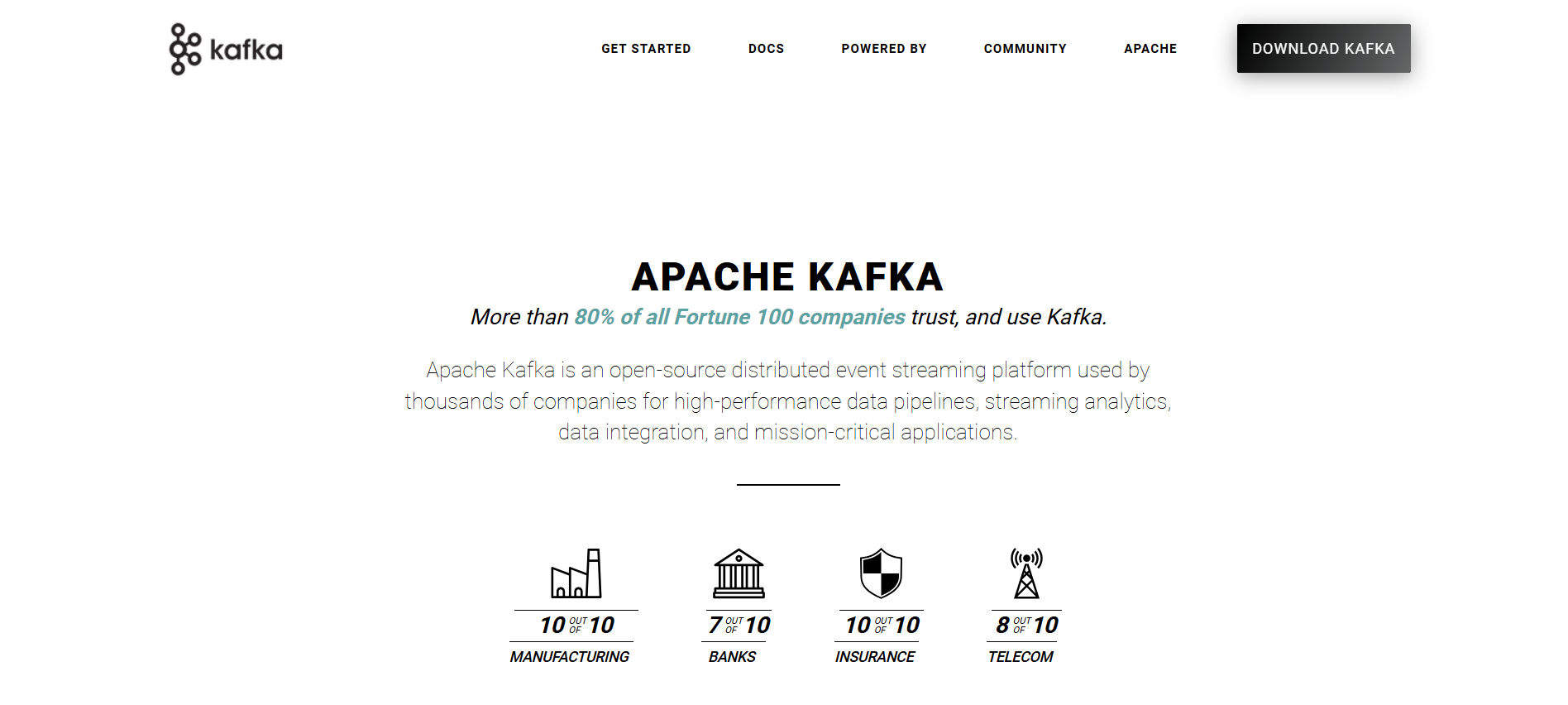
G2 Rating: 4.5
Founded in: 2011
Apache Kafka is one of the best open source tools with a distributed platform that enables high-performance data pipelines, real-time streaming analytics, seamless data integration, and mission-critical applications through its robust event streaming capabilities, widely adopted by numerous companies.
Apache Kafka ETL Features
- Scalable: I found Kafka incredibly scalable, allowing me to manage production clusters of up to a thousand brokers, handle trillions of messages per day, and store petabytes of data.
- Permanent Storage: Safely stores data streams in a distributed, durable, fault-tolerant cluster.
- High Availability: Kafka’s high availability features allowed me to efficiently stretch clusters across availability zones and connect separate clusters across geographic regions.
- Built-in Stream Processing: I utilized Kafka’s built-in stream processing capabilities to process event streams with joins, aggregations, filters, transformations, and more. This feature was particularly useful for real-time data processing and analytics.
- Wide Connectivity: Kafka’s Connect interface integrates with hundreds of event sources and sinks, including Postgres, JMS, Elasticsearch, AWS S3, and more.
Pros
- Handles large volumes of Data: Kafka is designed to handle high-volume data streams with low latency, making it suitable for real-time data pipelines and streaming applications. Apache Kafka users on G2 rate it as “Easy to use and integrate” and “Best option available to integrate event-based/real-time tools & applications.”
- Reliability: Being open-source, Apache Kafka is highly reliable and can be customized to meet specific organizational requirements.
Cons
- Kafka lacks built-in ETL capabilities like data transformation and loading, requiring additional tools or custom development to perform these steps effectively.
- The setup and maintenance of Kafka can be complex, making it less suitable for simple ETL pipelines in small to medium-sized companies.
Apache Kafka Resources
Documentation | Books and Papers
5. Pentaho Data Integration
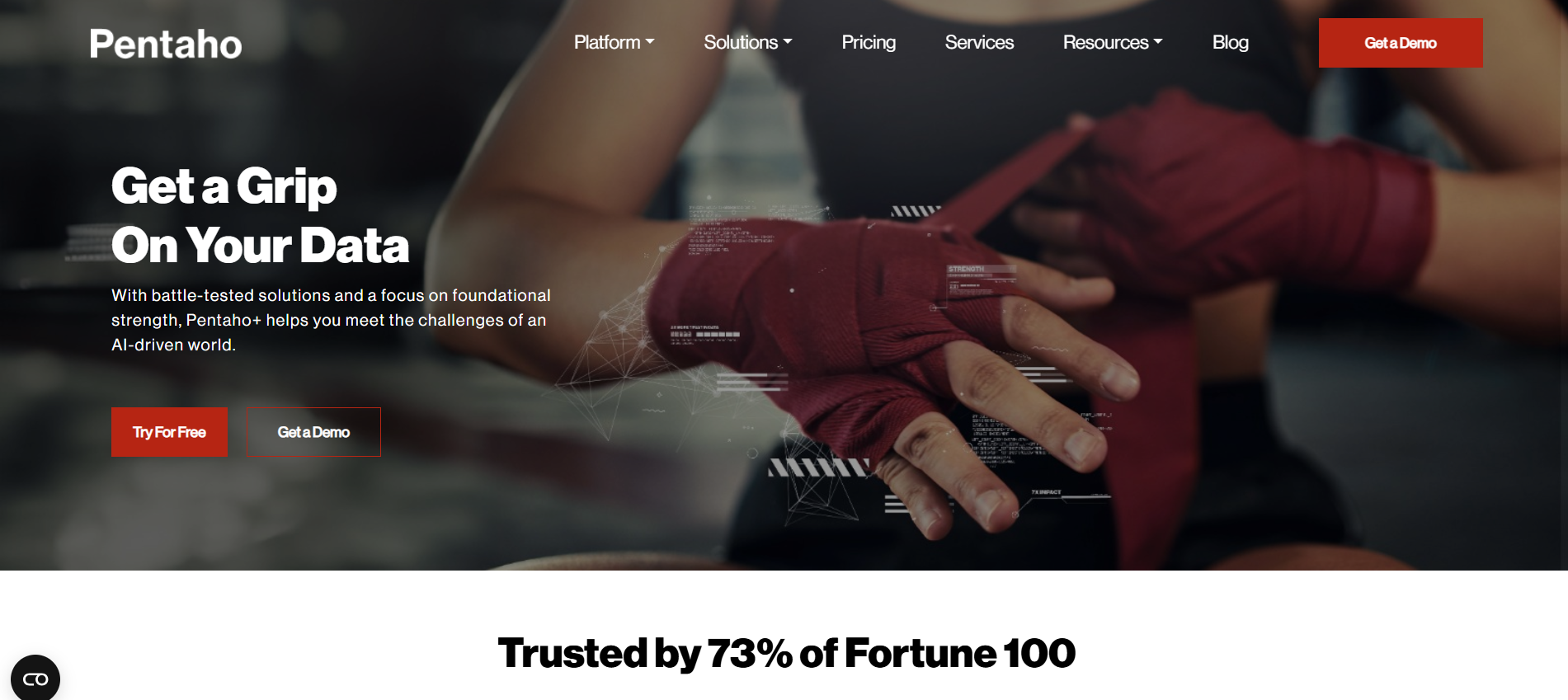
G2 Rating: 4.3
Founded in: 2004
Previously known as Pentaho Kettle, it is an open-source ETL solution that was acquired by Hitachi Data Systems in 2015 after its consistent success with enterprise users. Pentaho offers tools for both data integration and analytics, which allows users to easily integrate and visualize their data on a single platform.
Pentaho ETL Features
- Friendly GUI: Pentaho offers an easy drag-and-drop graphical interface which can even be used by beginners to build robust data pipelines.
- Accelerated Data Onboarding: With Pentaho Data Integration, I could quickly connect to nearly any data source or application and build data pipelines and templates that run seamlessly from the edge to the cloud.
- Metadata Injection: Pentaho’s metadata injection is a real time saver. With just a few tweaks, I could build a data pipeline template for a common data source and reuse it for similar projects. The tool automatically captured and injected metadata, like field datatypes, optimizing the data warehousing process for us.
Pros
- Free open-source: Pentaho is available as both a free and open-source solution for the community and as a paid license for enterprises.
- Pipeline Efficiency: Even for users without any coding experience, you can build efficient data pipelines yourself, giving time to focus on complex transformations and turn around data requests much faster for the team. A user on G2 says, “Excellent ETL UI for the non-programmer”.
- Flexibility: Pentaho is super flexible, I could connect data from anywhere: on-prem databases, cloud sources like AWS or Azure, and even from Docker containers.
Cons
- The documentation could be much better; finding examples of PDI’s functionalities can be quite challenging.
- The logging screen doesn’t provide detailed error explanations, making identifying the root cause of issues difficult. Additionally, the user community isn’t as robust as those of Microsoft or Oracle.
- Unless you pay for the tool, you’re pretty much on your own for implementation.
- PDI tends to be a bit slower compared to its competitors.
Pentaho Resources
Community | Documentation | Stack Overflow
6. Singer
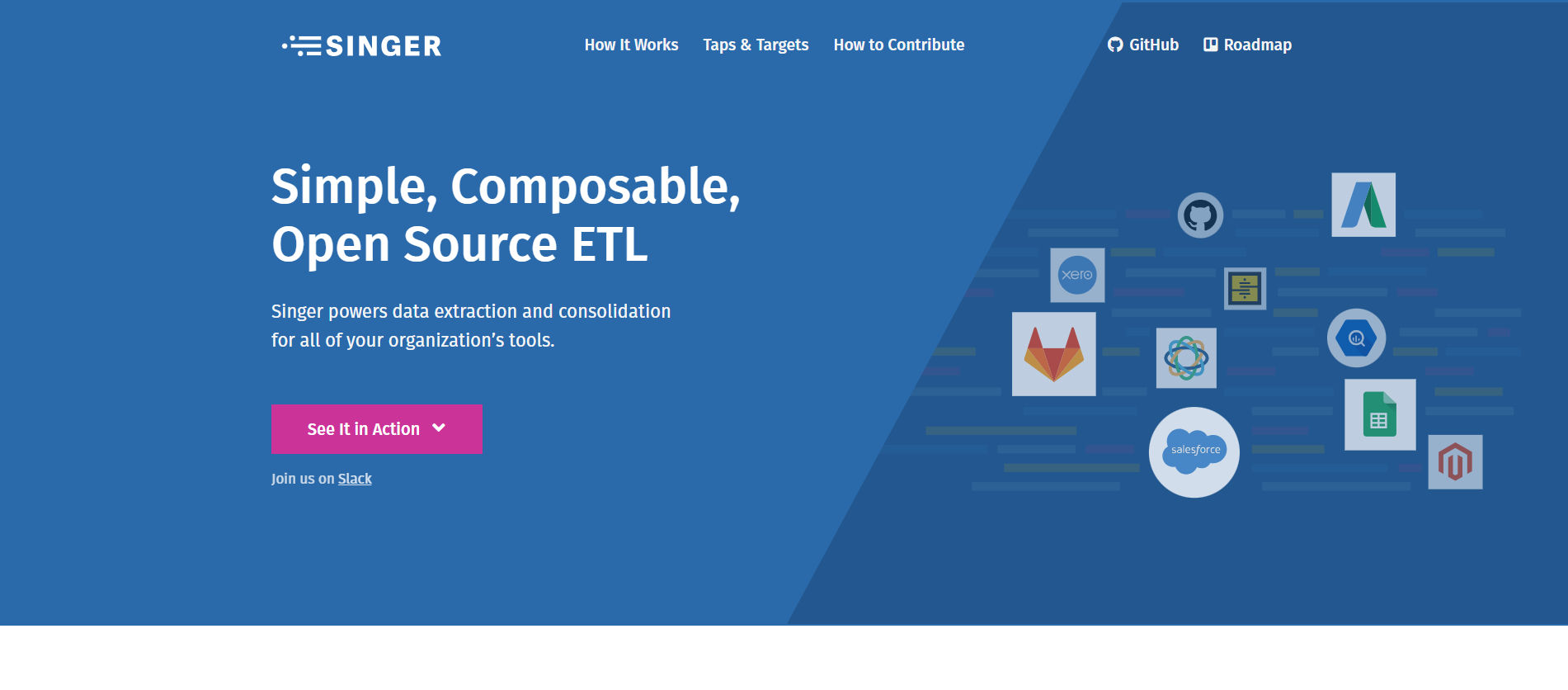
G2 Rating: NA
Founded in: NA
Singer is an open-source standard ETL solution sponsored by Stitch for seamless data movement across databases, web APIs, files, queues, and virtually any other imaginable source or destination. Singer describes how the data extraction scripts – “Taps” and data loading scripts – “Targets” should communicate, facilitating data movement.
Singer ETL Features
- Unix-inspired: No need for complex plugins or running daemons with Singer, it simplifies data extraction by utilizing straightforward applications connected through pipes.
- JSON-based: Singer is super versatile and avoids lock-in to a specific language environment since it follows JSON based communication, meaning you can use any programming language you’re comfortable with.
- Incremental Power: Singer’s ability to maintain state between runs is a huge plus. This means you can efficiently update your data pipelines without grabbing everything from scratch every time. It’s a real time saver for keeping your data fresh.
Pros
- Data Redundancy and Resilience: Singer’s tap and target architecture allowed me to load data into multiple targets, significantly reducing the risk of data loss or failure.
- Efficient Data Management: Singer’s architecture enables you to manage data more efficiently. By separating data producers (taps) from data consumers (targets), you can easily monitor and control data flow, ensuring that data is properly processed and stored.
Cons
- While Singer’s open-source nature offers flexibility in leveraging taps and targets, adapting them to fit custom requirements can be challenging due to the absence of standardization. This sometimes makes it tricky to utilize the connectors to meet your specific needs fully.
Singer Resources
7. PipelineWise
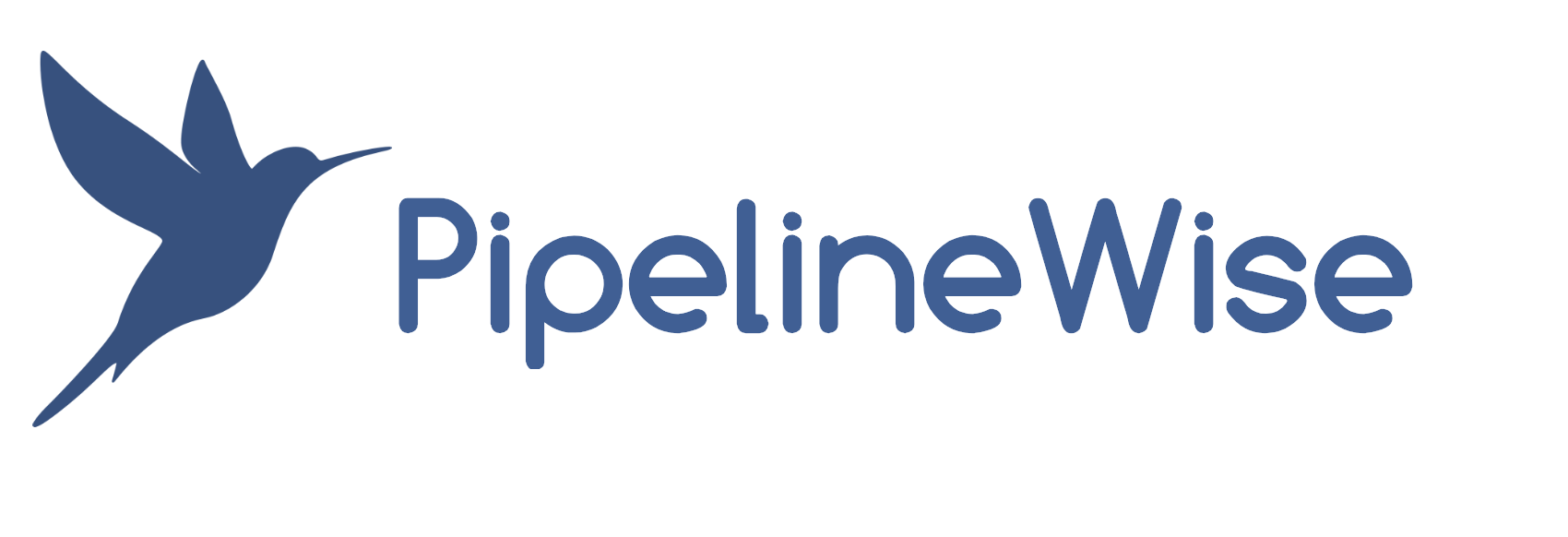
G2 Rating: NA
Founded in: 2018
PipelineWise is an open-source project developed by TransferWise, initially created to address their specific requirements. It is a Data Pipeline Framework that harnesses the Singer.io specification to efficiently ingest and replicate data from diverse sources to various destinations.
PipelineWise ETL Features
- Built for ETL: Unlike traditional tools for ETL, PipelineWise is built to integrate into the ETL workflow seamlessly. Its primary purpose is to replicate your data in its original format from source to an Analytics-data-store, where complex data mapping and joins are performed.
- YAML-based configuration: I defined my data pipelines as YAML (yet another markup language) files to ensure all the configurations were under version control.
- Replication Methods: PipelineWise supports three data replication methods—log-based change data capture (CDC), key-based incremental updates, and full table snapshots.
Pros
- Lightweight: Pipelinewise is lightweight, so I didn’t have to set up any daemons or databases for operations.
- Security: PipelineWise is ideal for obfuscating, masking, and filtering sensitive business data. This ensures that such data is not replicated in your warehouse during load-time transformations.
Cons
- While PipelineWise supports micro-batch data replication, creating these batches adds an extra layer to the process, causing a lag of 5 to 30 minutes, making real-time replications impossible.
- There is no community, so no support is provided for PipelineWise, but it has open-sourced documentation available.
PipelineWise Resources
Documentation | Licenses | Slack
8. Apache NiFi
I’ve worked with Apache NiFi, and it’s been an incredible experience in automating data flow between systems. As an open-source tool, it stands out for its focus on data flow automation, ensuring secure and efficient data transfer. What I found particularly fascinating is its design, based on the flow-based programming model—making it intuitive to use.
Apache NiFi Key Features
- Data Provenance Tracking: One of my standout features was its ability to provide a complete information lineage. I could trace data from its origin to its final destination, which was invaluable for troubleshooting and maintaining transparency.
- Data Ingestion: NiFi excelled at collecting data from various sources. Whether it was log files, sensor data, or application-generated information, the tool handled it seamlessly. Depending on my needs, I had the flexibility to ingest data in real-time or batch processes.
- Data Enrichment: Another helpful feature was how NiFi enriched the data by adding details like timestamps, geolocation data, or user IDs. This improved data quality and made it ready for analysis right out of the gate.
Pros
- User-Friendly Interface: The drag-and-drop interface made it easy for me to design and manage data flows without writing much code.
- Scalable and Flexible: I could handle both real-time and batch data effortlessly, making it suitable for a variety of use cases and data volumes.
- Built-in Security: I appreciated the secure protocol support and fine-grained access controls, ensuring safe and compliant data transfers.
Cons
- Steep Learning Curve: While the interface is beginner-friendly, mastering advanced configurations and optimizations took some time.
- Performance Overhead: I had to spend extra time tuning the system for very high-throughput scenarios to avoid bottlenecks.
- Resource-Intensive: NiFi requires significant system resources, especially when running large-scale workflows with complex data flows.
Apache NiFi Resources
Special Mention: Talend Open Studio for Data Integration
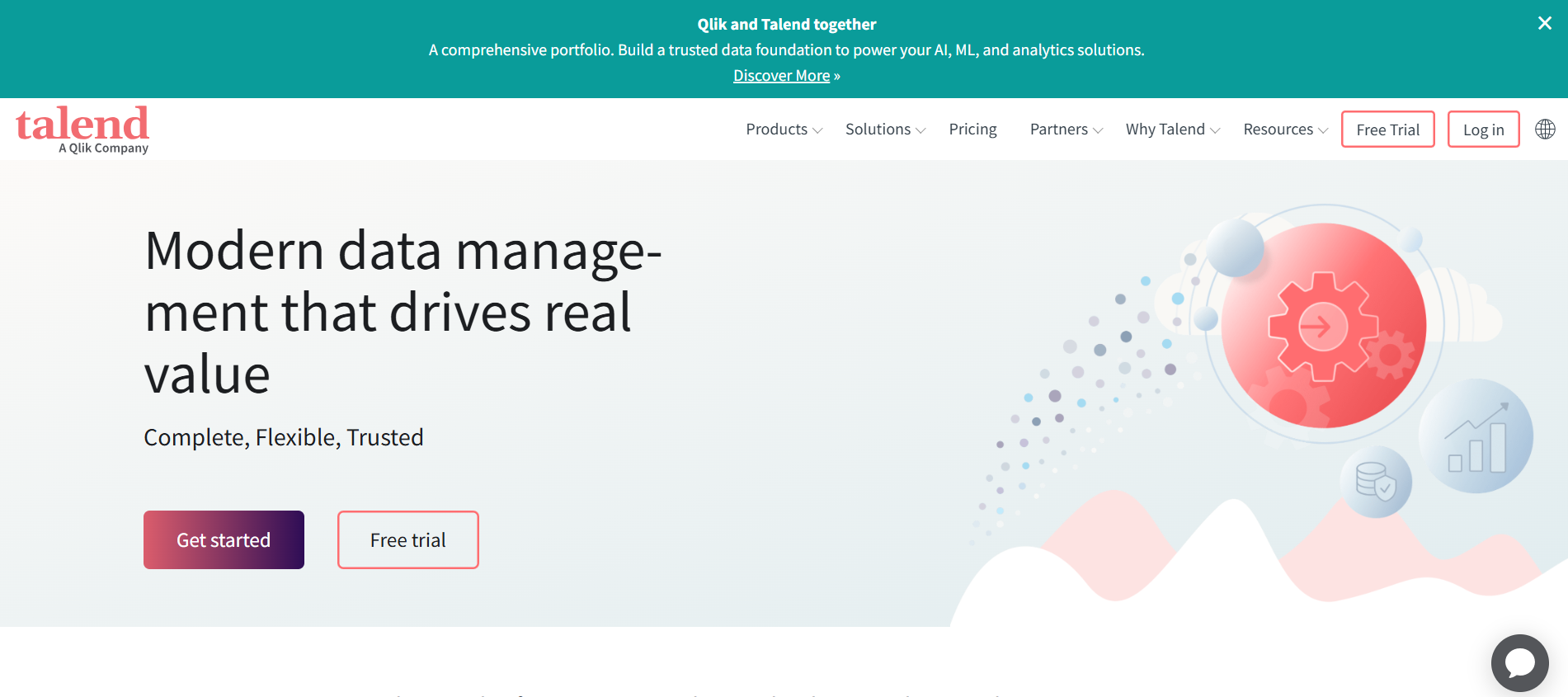
Last but not least, Talend Open Studio deserves special mention as a free, open-source ETL tool that has been available for the past 20 years. However, due to declining community adoption, Talend has made the difficult decision to discontinue the open-source version of Talend Studio. In response, they have partnered with Qlik to offer free and paid versions of their data integration platform, continuing their commitment to data quality and integration.
Features Offered by Talend:
- ETL: Talend is one tool for complete ETL. It extracts, transforms, and loads data from various sources into your target destinations.
- Drag-and-Drop: Without writing a single line of code, we can perform transformations using the drag-and-drop methodology.
Discover top Talend alternatives in our latest blog.
Additional Tools to Consider
Apart from these seven most popular free open-source ETL tools, I also tried the following 3 open-source tools that have been making a buzz in the market and are definitely worth a try.
- pygrametl: pygrametl is a free, open-source tools Python library built for developers who like to get control of their pipelines. It offers tools specifically designed for building ETL (Extract, Transform, Load) pipelines. As an ETL framework, pygrametl focuses on the data processing logic within your ETL pipelines, assuming the tables already exist, rather than creating the data warehouse schema itself.
- Scriptella: Scriptella is an open-source ETL tool built for simplicity. Forget complex configurations – you can write your data transformation tools open source using familiar languages like SQL, directly within the tool. This makes Scriptella a user-friendly option, especially for those already comfortable with SQL or other scripting languages.
- Logstash: Logstash is an Open-Source Data Pipeline that extracts data from multiple data sources, transforms the source data and events, and loads them into ElasticSearch, a JSON-based search and analytics engine. It is part of the ELK Stack. The “E” stands for ElasticSearch, and the “K” stands for Kibana, a Data Visualization engine.
Take a look at the key differences between ETL vs ELT in detail to get a clear understanding of the two processes.
Learn how ETL vs. Reverse ETL compares in serving different data needs.
Checklist to Choose the Right Open-Source ETL Tool
While choosing the right tool for your business, ensure you check for the following points:
- Technical Expertise: Consider your team’s comfort level with coding and scripting requirements for different tools.
- Data Volume and Complexity: Evaluate the volume of data you handle and the complexity of transformations needed.
- Deployment Preferences: Choose between on-premises deployment for more control or cloud-based solutions for scalability.
- Budget Constraints: While open source data integration tools eliminate licensing fees, consider potential costs for infrastructure or additional support needs.
I created a detailed checklist of factors that you should consider before choosing an open-source ETL tool. If your preferred solution checks all the boxes on the following list, you are on the right track!
| Criteria | Description | Check |
| Ease of Use | Does the tool have an intuitive interface, such as drag-and-drop, or does it require extensive coding? | ✔ |
| Data Source Compatibility | Does the tool support integration with the data sources you use (databases, APIs, files, etc.)? | ✔ |
| Transformation Capabilities | Can the tool handle complex data transformations like filtering, aggregation, and enrichment? | ✔ |
| Scalability | Can the tool scale to handle large volumes of data or complex workflows as your needs grow? | ✔ |
| Real-Time Support | Does the tool support real-time data processing in addition to batch processing? | ✔ |
| Performance | Is the tool optimized for high-speed data extraction, transformation, and loading? | ✔ |
| Security Features | Does the tool offer secure data transfer, access controls, and encryption? | ✔ |
| Extensibility | Can the tool be extended or customized using plugins, scripts, or custom processors? | ✔ |
| Community and Support | Is there a strong user community or official support for troubleshooting and guidance? | ✔ |
| Documentation | Does the tool offer comprehensive documentation and tutorials? | ✔ |
| Cost of Maintenance | While open-source tools are free, does the tool require significant resources or expertise to maintain? | ✔ |
| Cloud and On-Premises Compatibility | Does the tool work well in your deployment environment (cloud, on-premises, or hybrid)? | ✔ |
Also, check out the Best ETL Tools for a Data Warehouse and the Best Data Transformation Tools that you can use in 2025.


My Take
As you evaluate your data integration needs for the year ahead, the eight open-source, free tools for ETL highlighted in this post -Hevo, dbt, Airbyte, Apache Kafka, Pentaho Data Integration, Singer, NiFi, and PipelineWise – each offers unique strengths and capabilities to consider.
Whether you’re a small business looking for an easy-to-use solution or an enterprise seeking advanced data orchestration and operations features, there is likely an option here to help streamline your data workflows and make the most out of your data.
Want to take Hevo for a spin? Sign up for a 14-day free trial and experience the feature-rich Hevo suite firsthand. You can also have a look at the unbeatable pricing that will help you choose the right plan for your business needs.
In-Depth Analyses of Popular Open Source Tools
- PostgreSQL ETL Tools
- Python ETL Tools
- Top 12 Open Source Ci Cd Tools
- Top 10 Tableau Open Source
- No code ETL tools
FAQ
1. What are the best open-source tools for ETL?
The top 7 best open-source tools for ETL include – Hevo, Airbyte, Apache Kafka, Pentaho Data Integration, dbt, PipelineWise, and Singer.
2. Is Talend still open source?
Talend provides both open-source and commercial versions of its software.
3. Is Kafka an ETL tool?
Kafka is not traditionally considered an ETL (Extract, Transform, Load) tool. Instead, Kafka is a distributed event streaming platform used for real-time data pipeline and event processing.
4. Is Kettle ETL free?
Yes, Kettle, also known as Pentaho Data Integration, is an open-source ETL (Extract, Transform, Load) tool.
5. What Are Open-Source ETL Tools?
Open-source ETL tools are data integration platforms whose source code is publicly available. They help extract, transform, and load data across systems and can be customized to fit specific workflows.
6. What are the Pros and Cons of Open Source ETL Tools
Pros: Free to use, highly customizable, and supported by active developer communities.
Cons: Require engineering effort to set up and maintain, limited customer support, and may lack advanced features available in commercial tools.



